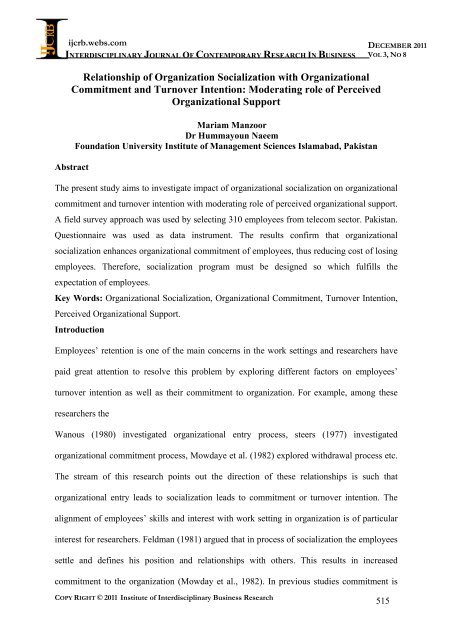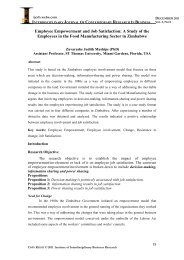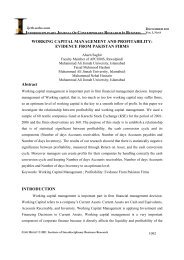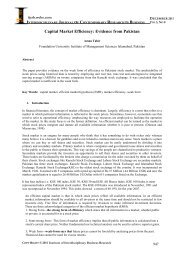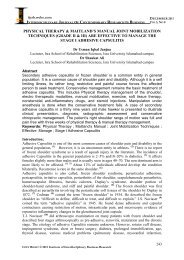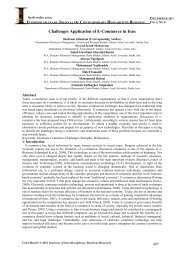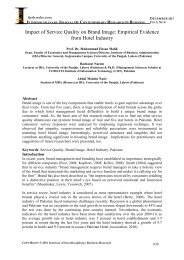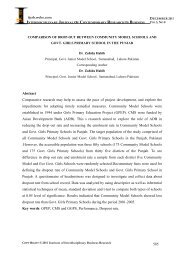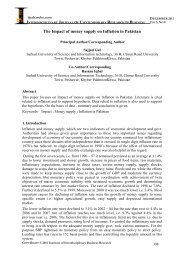Relationship of Organization Socialization with Organizational ...
Relationship of Organization Socialization with Organizational ...
Relationship of Organization Socialization with Organizational ...
You also want an ePaper? Increase the reach of your titles
YUMPU automatically turns print PDFs into web optimized ePapers that Google loves.
ijcrb.webs.com<br />
INTERDISCIPLINARY JOURNAL OF CONTEMPORARY RESEARCH IN BUSINESS<br />
DECEMBER 2011<br />
VOL 3, NO 8<br />
<strong>Relationship</strong> <strong>of</strong> <strong>Organization</strong> <strong>Socialization</strong> <strong>with</strong> <strong>Organization</strong>al<br />
Commitment and Turnover Intention: Moderating role <strong>of</strong> Perceived<br />
<strong>Organization</strong>al Support<br />
Abstract<br />
Mariam Manzoor<br />
Dr Hummayoun Naeem<br />
Foundation University Institute <strong>of</strong> Management Sciences Islamabad, Pakistan<br />
The present study aims to investigate impact <strong>of</strong> organizational socialization on organizational<br />
commitment and turnover intention <strong>with</strong> moderating role <strong>of</strong> perceived organizational support.<br />
A field survey approach was used by selecting 310 employees from telecom sector. Pakistan.<br />
Questionnaire was used as data instrument. The results confirm that organizational<br />
socialization enhances organizational commitment <strong>of</strong> employees, thus reducing cost <strong>of</strong> losing<br />
employees. Therefore, socialization program must be designed so which fulfills the<br />
expectation <strong>of</strong> employees.<br />
Key Words: <strong>Organization</strong>al <strong>Socialization</strong>, <strong>Organization</strong>al Commitment, Turnover Intention,<br />
Perceived <strong>Organization</strong>al Support.<br />
Introduction<br />
Employees’ retention is one <strong>of</strong> the main concerns in the work settings and researchers have<br />
paid great attention to resolve this problem by exploring different factors on employees’<br />
turnover intention as well as their commitment to organization. For example, among these<br />
researchers the<br />
Wanous (1980) investigated organizational entry process, steers (1977) investigated<br />
organizational commitment process, Mowdaye et al. (1982) explored <strong>with</strong>drawal process etc.<br />
The stream <strong>of</strong> this research points out the direction <strong>of</strong> these relationships is such that<br />
organizational entry leads to socialization leads to commitment or turnover intention. The<br />
alignment <strong>of</strong> employees’ skills and interest <strong>with</strong> work setting in organization is <strong>of</strong> particular<br />
interest for researchers. Feldman (1981) argued that in process <strong>of</strong> socialization the employees<br />
settle and defines his position and relationships <strong>with</strong> others. This results in increased<br />
commitment to the organization (Mowday et al., 1982). In previous studies commitment is<br />
COPY RIGHT © 2011 Institute <strong>of</strong> Interdisciplinary Business Research<br />
515
ijcrb.webs.com<br />
INTERDISCIPLINARY JOURNAL OF CONTEMPORARY RESEARCH IN BUSINESS<br />
DECEMBER 2011<br />
VOL 3, NO 8<br />
being tried to be understood through alternative dimensions and its role in both theory and<br />
practice. Although, numerous researchers have tried to provide rich insight to commitment<br />
and turnover literature however, there is still a need to explore more determinants <strong>of</strong><br />
commitment as well as turnover intention (Cohen, 2003). One <strong>of</strong> such determinants is<br />
organizational socialization which is mostly ignored in context <strong>of</strong> commitment and turnover.<br />
Along <strong>with</strong> it research focused all <strong>of</strong> these constructs isolate and didn’t take all <strong>of</strong> them in<br />
one context. This lack <strong>of</strong> studies about commitment and turnover along <strong>with</strong> socialization is<br />
one <strong>of</strong> the major gaps in literature.<br />
As socialization is the process which can influence commitment levels <strong>of</strong> employees<br />
(Saks et al., 2007), therefore, it is reasonable to explore the relationship between<br />
socialization, commitments and turnover intention. Therefore, present study has taken an<br />
attempt to address this issue by fulfilling literature gap. It aims to investigate impact <strong>of</strong><br />
organizational socialization on organizational commitment and turnover intention <strong>with</strong><br />
moderating role <strong>of</strong> perceived organizational support. The objectives <strong>of</strong> the study are<br />
• To find out the relationship between employees socialization, commitment and turn<br />
over.<br />
• To find the interactional effect <strong>of</strong> perceived organizational support upon this<br />
relationship.<br />
The study will provide more general aspect <strong>of</strong> socialization and it will <strong>of</strong>fer useful<br />
implications for organizations, mangers, human resource management staff and academia.<br />
Literature Review<br />
<strong>Socialization</strong> can be defined as “socialization is the activity that confronts and lends structure<br />
to the entry <strong>of</strong> non-members into an already existing world or a sector <strong>of</strong> that world”<br />
(Wentworth, 1980). It exerts a surprising impact on employees’ performance and<br />
organizational stability. This process <strong>of</strong> organizational socialization is a performance<br />
COPY RIGHT © 2011 Institute <strong>of</strong> Interdisciplinary Business Research<br />
516
ijcrb.webs.com<br />
INTERDISCIPLINARY JOURNAL OF CONTEMPORARY RESEARCH IN BUSINESS<br />
DECEMBER 2011<br />
VOL 3, NO 8<br />
management concern, and several researches have confirmed its strong association <strong>with</strong><br />
organizational commitment and job satisfaction which are related <strong>with</strong> turnover intention<br />
(Fisher, 1986). <strong>Socialization</strong> resources theory argued that organizations should<br />
Design effective orientation training programs that guide new employees about each<br />
aspect <strong>of</strong> stressful situations <strong>of</strong> organization as well as strategies to cope <strong>with</strong> them. Ashforth,<br />
et al. (2007), pointed out that socialization is significant because it presents new employees<br />
about realistic scenario <strong>of</strong> importance <strong>of</strong> organization as well all <strong>of</strong> its potential for new<br />
employees. The primary purpose <strong>of</strong> socialization is to provide employees <strong>with</strong> accurate<br />
information in the form <strong>of</strong> a realistic job preview before entering organizational.<br />
Effective socialization can have long lasting productive effects on employees by<br />
increasing person-organization fit and person-job fit as well as organizational commitment.<br />
<strong>Socialization</strong> can <strong>of</strong>fer its benefits by reducing uncertainty. Uncertainty reduction theory<br />
states that, “newcomers desire to increase the predictability <strong>of</strong> interactions between<br />
themselves and others <strong>with</strong>in the new organization” (Bauer et al., 2007, p. 708). Uncertainty<br />
reduction theory is the foundation for research on newcomer employees information seeking<br />
and proactivity (Miller & Jablin, 1991).<br />
<strong>Organization</strong>al Commitment<br />
Previous studies have shown that newcomers employees who are more socialized have high<br />
level <strong>of</strong> commitment than their less-socialized colleagues. As socialization provides<br />
employees <strong>with</strong> clear set information, which in turns helps them to cope <strong>with</strong> stress and<br />
others matters <strong>of</strong> job, thus, increasing their affection <strong>with</strong> the organization (Allen and Meyer,<br />
1990). There is a research view which argues that different organizational socialization<br />
techniques have different effects on various forms <strong>of</strong> commitment (Cohen, 2003). In fact<br />
organizational socialization is the way to assist employees in keeping fit for effective work<br />
(Mowday et al., 1982) thus significantly effecting their level <strong>of</strong> commitment. Buchanan<br />
COPY RIGHT © 2011 Institute <strong>of</strong> Interdisciplinary Business Research<br />
517
ijcrb.webs.com<br />
INTERDISCIPLINARY JOURNAL OF CONTEMPORARY RESEARCH IN BUSINESS<br />
DECEMBER 2011<br />
VOL 3, NO 8<br />
(1974) also noted that new employees are basically worried about getting established and<br />
accepted by the organization. In this way they make deliberate efforts to prove themselves by<br />
showing that they have the ability to adjust to the demands <strong>of</strong> the new environment. Thus it is<br />
hypothesized that<br />
H1. <strong>Organization</strong> socialization has positive relationship <strong>with</strong> organizational commitment.<br />
Turn over Intention<br />
<strong>Organization</strong>al turnover has shown highest rates among new employees (Griffeth & Hom,<br />
2001). One <strong>of</strong> the major factors effecting turnover intention <strong>of</strong> new employees is poor<br />
socialization (Fisher, 1986). A large body <strong>of</strong> research shows that socialization strategies are<br />
related to turnover and it effects turnover in three ways: by influencing job satisfaction,<br />
organizational commitment, and met expectations (e.g., Cable&Judge, 1996; Saks&Ashforth,<br />
1997); by influencing perceptions <strong>of</strong> person-organization (P-O) fit and values congruence<br />
(e.g., Cable & Parsons, 2001; Cooper-Thomas et al, 2004) and by influencing newcomers’<br />
adjustment to their new jobs and environments (Cooper-Thomas & Anderson, 2002;<br />
Kammeyer-Mueller & Wanberg, 2003). When new employees enter organizations, the<br />
disconfirmation <strong>of</strong> their unrealistic expectations results in their dissatisfaction <strong>with</strong> job and<br />
thus increase chances <strong>of</strong> turnover (Wanous, et al. 1992). However, successful socialization<br />
designed by organization may result in successful adjustment in form <strong>of</strong> organizational<br />
commitment, job satisfaction, social integration, role clarity, and fit and low turnover<br />
intention (e.g., Bauer & Green, 1998; Wanberg &Kammeyer-Mueller, 2000). Thus, it is<br />
hypothesized that<br />
H2. <strong>Organization</strong> socialization has negative relationship <strong>with</strong> turnover intention.<br />
COPY RIGHT © 2011 Institute <strong>of</strong> Interdisciplinary Business Research<br />
518
ijcrb.webs.com<br />
INTERDISCIPLINARY JOURNAL OF CONTEMPORARY RESEARCH IN BUSINESS<br />
DECEMBER 2011<br />
VOL 3, NO 8<br />
Perceived <strong>Organization</strong>al Support:<br />
Perceived organizational support is employees’ “perception <strong>of</strong> being valued and cared about<br />
by the organization” (Eisenberger, et al. 1990). Employees’ perceived organizational support<br />
makes employees feel obliged to be committed to the organization (Eisenberger et al., 1990).<br />
They also found positive relationships between perceived organizational support and<br />
performance. Waung (1995) confirmed that the new employees’ positive perception about<br />
organizational support results in high organization commitment, which in turn produces<br />
lower intention to quit.<br />
According to Tourangeau and Cranley (2006), perceived support is an important factor that<br />
indirectly affects the intention to remain employed. Waung (1995) also found, perceived<br />
organizational support as a mediator <strong>of</strong> the effect <strong>of</strong> a coping orientation on organizational<br />
commitment and intent to quit. Thus it is hypothesized that<br />
H3. <strong>Relationship</strong> between <strong>Organization</strong> <strong>Socialization</strong> and <strong>Organization</strong> commitment is<br />
moderated by perceived organization support.<br />
H4. <strong>Relationship</strong> between <strong>Organization</strong> <strong>Socialization</strong> and Turnover intention is moderated<br />
by perceived organization support.<br />
COPY RIGHT © 2011 Institute <strong>of</strong> Interdisciplinary Business Research<br />
519
ijcrb.webs.com<br />
INTERDISCIPLINARY JOURNAL OF CONTEMPORARY RESEARCH IN BUSINESS<br />
DECEMBER 2011<br />
VOL 3, NO 8<br />
<strong>Organization</strong>al<br />
commitment.<br />
<strong>Organization</strong> socialization<br />
Turnover Intention.<br />
Perceived <strong>Organization</strong><br />
Support<br />
(Moderating Variable)<br />
Fig 1: Proposed Research Model<br />
Method<br />
Data Collection and Sample: The data collection was done through onsite administration <strong>of</strong> a<br />
survey to employees who were working in telecom sector <strong>of</strong> Pakistan. The participants were<br />
randomly sampled across departments and ranks. The reason <strong>of</strong> simple random sampling<br />
technique for data collection was that it was difficult to select the data from only a one<br />
specified sector; people are no more research oriented. Thus, the design <strong>of</strong> study is cross<br />
sectional.<br />
These individuals were sent covering letters in which it was mentioned the<br />
purpose and scope <strong>of</strong> the study and it was assured that their responses would be retained<br />
completely confidential. Total 400 questionnaires were distributed. Out <strong>of</strong> 400, only 300<br />
usable responses were received. Thus, total response rate was 75%.<br />
Measures: In Pakistan, English is the <strong>of</strong>ficial language <strong>of</strong> correspondence in all <strong>of</strong>fices as<br />
well as medium <strong>of</strong> instruction in educational institutions. Therefore, in the questionnaires all<br />
the questions were written in English language. Usually, researchers used questionnaires in<br />
English in Pakistan (Raja and Johns, 2010).Self-report questionnaires were used for all the<br />
COPY RIGHT © 2011 Institute <strong>of</strong> Interdisciplinary Business Research<br />
520
ijcrb.webs.com<br />
INTERDISCIPLINARY JOURNAL OF CONTEMPORARY RESEARCH IN BUSINESS<br />
DECEMBER 2011<br />
VOL 3, NO 8<br />
measures. All variables were rated on 5 point likert scale ranging from 1 depicted “strongly<br />
disagree”, 5 “strongly agree”.<br />
Results<br />
The demographic pr<strong>of</strong>ile <strong>of</strong> 300 respondents in table 1 shows that majority (79%)<br />
respondents were males, while 21% were females. The statistics <strong>of</strong> experience years <strong>of</strong><br />
employees show that 40% respondents had 1-6 years experience, while 33% and 27% were<br />
having less than 1 and more than 6 years <strong>of</strong> experience respectively. The maximum age <strong>of</strong><br />
respondents was above 30 years, 25.3% were <strong>of</strong> age range 25-30 years and only 19% were<br />
below 25 years. In table 1 demographic information <strong>of</strong> respondents is given<br />
Gender<br />
Job Duration<br />
Age<br />
Table 1: Characteristics <strong>of</strong> Sample<br />
Category Frequency Percentage<br />
Male 237 79<br />
Female 63 21<br />
Less than 1 year 99 33<br />
1-6 years 120 40<br />
More than 6 Years 81 27<br />
>25 years 58 19<br />
25-30 years 76 25.3<br />
ijcrb.webs.com<br />
INTERDISCIPLINARY JOURNAL OF CONTEMPORARY RESEARCH IN BUSINESS<br />
DECEMBER 2011<br />
VOL 3, NO 8<br />
Reliability analysis <strong>of</strong> factors: Reliability analysis is the measure taken to ensure that the<br />
scale is consistently measuring the constructs used in questionnaire. It is used to measure the<br />
internal consistency <strong>of</strong> items. The most common measure <strong>of</strong> scale reliability is Cronbach’s<br />
alpha, which is used in this research. The value <strong>of</strong> Cronbach’s alpha reliability coefficient<br />
normally ranges between 0 and 1. The closer Cronbach’s alpha coefficient near to 1.0 shows<br />
the greater internal consistency <strong>of</strong> the items in the scale. The table 2 shows the constructs,<br />
number <strong>of</strong> their items and values <strong>of</strong> reliability analysis. The values in table indicate that all <strong>of</strong><br />
the factors have the individual value <strong>of</strong> Cronbach alpha above 0.7, which is deemed<br />
significant. The highest value <strong>of</strong> alpha was <strong>of</strong> the factor Turn over Intention i.e., 0.90 and the<br />
lowest value was <strong>of</strong> the factor <strong>Organization</strong>al <strong>Socialization</strong>, which was 0.74.<br />
Table 2: Reliability <strong>of</strong> construct measures<br />
Construct Number <strong>of</strong> Items Composite Reliability<br />
<strong>Organization</strong>al <strong>Socialization</strong> 20 0.74<br />
<strong>Organization</strong>al Support 24 0.89<br />
<strong>Organization</strong>al Commitment 3 0.92<br />
Turn over Intention 3 0.90<br />
In order to evaluate the direct relationship between independent and dependent variable<br />
simple regression analysis was carried out. The output values are given in table 3. The values<br />
<strong>of</strong> beta <strong>of</strong> theoretical relationship <strong>of</strong> socialization and commitment is positive (0.78**) which<br />
shows that a change <strong>of</strong> one standard deviation in the socialization will result in a change <strong>of</strong><br />
0.78 standard deviations in the commitment. Thus H1 is supported. On contrary the beta<br />
values <strong>of</strong> variable socialization and turnover intention is negative (_0.30*), showing one<br />
standard deviation increase in socialization will cause _0.30* standard deviation decrease in<br />
COPY RIGHT © 2011 Institute <strong>of</strong> Interdisciplinary Business Research<br />
522
ijcrb.webs.com<br />
INTERDISCIPLINARY JOURNAL OF CONTEMPORARY RESEARCH IN BUSINESS<br />
DECEMBER 2011<br />
VOL 3, NO 8<br />
turnover intention. Thus H2 is supported. The significant values <strong>of</strong> F and R 2 show that<br />
<strong>Organization</strong>al <strong>Socialization</strong>, <strong>Organization</strong>al Commitment and Turn over Intention do a good<br />
job explaining the relationships. All the values confirm the significant good fit <strong>of</strong> model.<br />
Table 3: Regression Analysis<br />
Independent<br />
Variable<br />
<strong>Socialization</strong><br />
Dependent<br />
variables<br />
Beta R 2 F sig<br />
Commitment 0.78** 0.32** 250.15 0.000<br />
Turnover intention _0.30* 0.47* 315.50 0.001<br />
Moderating effect <strong>of</strong> Perceived organizational Support<br />
In order to test the hypotheses regarding the moderating effect <strong>of</strong> perceived organizational<br />
support on the relationships between organizational socialization and the dimensions <strong>of</strong><br />
organizational commitment and turnover intention, a two-step hierarchical multiple<br />
regression was used. In the first step, the dependent variable is regressed on both the<br />
independent and moderating variables. In the second step, an interaction term, created by the<br />
multiplication <strong>of</strong> the scores obtained from the two variables entered in the first step, is added<br />
to the regression model. The moderating effect is supported when the regression coefficient<br />
associated <strong>with</strong> the interaction term is significant (p
ijcrb.webs.com<br />
INTERDISCIPLINARY JOURNAL OF CONTEMPORARY RESEARCH IN BUSINESS<br />
DECEMBER 2011<br />
VOL 3, NO 8<br />
Table 4: Moderating effect <strong>of</strong> Perceived organizational Support<br />
Model B SE B β ∆ R 2<br />
Dependent variable: affective<br />
commitment<br />
Step 1<br />
O-<strong>Socialization</strong> 0.42 0.03 0.51<br />
POS -0.12 0.06 _0.23<br />
Step 2<br />
OS X POS 0.17 0.03 0.15* 0.24**<br />
Dependent variable Turnover intention<br />
Step 1<br />
O-<strong>Socialization</strong> _0.04 0.05 -0.02<br />
POS 0.30 0.12 0.34**<br />
Step 2<br />
OS X POS -0.05 0.03 -0.15** 0.45**<br />
Note: β Standardized regression coefficient; * p
ijcrb.webs.com<br />
INTERDISCIPLINARY JOURNAL OF CONTEMPORARY RESEARCH IN BUSINESS<br />
DECEMBER 2011<br />
VOL 3, NO 8<br />
organizational commitment <strong>of</strong> employees, thus reducing cost <strong>of</strong> losing employees. The effect<br />
<strong>of</strong> organizational socialization on commitment is mediated by perceived organizational<br />
support. It means that if employees perceived organizational support it will increase their<br />
commitment. Therefore, socialization program must be designed so which fulfills the<br />
expectation <strong>of</strong> employees. Thus, employees’ commitment, low turnover and positive<br />
organizational support can have great optimistic effect on organizational productivity. It<br />
canbe concluded that organizational socialization, low turnover intentions, employees<br />
commitment through perceived organizational support provides enough potential <strong>of</strong><br />
organizational productivity. Therefore, it is recommended to provide adequate support<br />
through HRM practices, and create supportive environment for making employees happy and<br />
better.<br />
COPY RIGHT © 2011 Institute <strong>of</strong> Interdisciplinary Business Research<br />
525
ijcrb.webs.com<br />
INTERDISCIPLINARY JOURNAL OF CONTEMPORARY RESEARCH IN BUSINESS<br />
DECEMBER 2011<br />
VOL 3, NO 8<br />
References<br />
Allen, N.J. and J.P. Meyer. (1990). <strong>Organization</strong>al <strong>Socialization</strong> Tactics: A Longitudinal<br />
Analysis <strong>of</strong> Links to Newcomers' Commitment and Role Orientation. Academy <strong>of</strong><br />
Management Journal, 33, 857-858<br />
Ashforth, D.M; Sluss and S.H. Harrison. (2007). <strong>Socialization</strong> in organizational contexts.<br />
International Review <strong>of</strong> Industrial and <strong>Organization</strong>al Psychology, 22 . pp. 1–70.<br />
Bauer, T. N., Morrison, E. W., & Callister, R. R. (1998). <strong>Organization</strong>al socialization: A<br />
review and directions for future research. In K. M. Rowland & G. R. Ferris (Eds.), Research<br />
in personnel and human resources management (Vol. 16, pp. 149-214). Greenwich, CT:<br />
JAI Press<br />
Bauer,T. N.,&Green, S. G. (1998).Testing the combined effects <strong>of</strong> new comer information<br />
seeking and manager behavior on socialization. Journal <strong>of</strong> Applied Psychology, 83:<br />
72- 83.<br />
Buchanan, B. (1974). Building <strong>Organization</strong>al Commitment: The <strong>Socialization</strong> <strong>of</strong> Managers<br />
in Work <strong>Organization</strong>s. Administrative Science Quarterly, 19, 533-546.<br />
Cable, D. M.,&Judge, T. A. (1996). Person-organization fit, job choice decisions, and<br />
organizational entry. <strong>Organization</strong>al Behavior and Human Decision Processes, 67:<br />
294- 311<br />
Cable, D. M.,&Parsons, C. K. (2001). <strong>Socialization</strong> tactics and person-organization fit.<br />
Personnel Psychology, 54: 1- 23.<br />
Cohen, A. (2003), Multiple Commitments in the Workplace: an Integrative Approach,<br />
Lawrence Erlbaum Associates, Mahwah, NJ.<br />
Cooper-Thomas, H. D., van Vianen, A., & Anderson, N. (2004). Changes in personorganization<br />
fit: The impact <strong>of</strong> socialization tactics on perceived and actual P-O fit.<br />
European Journal <strong>of</strong> Work and <strong>Organization</strong>al Psychology, 13: 52-78<br />
Cooper-Thomas, H., & Anderson, N. (2002). Newcomer adjustment: The relationship<br />
between organizational social-ization tactics, information acquisitionand attitudes.<br />
Journal <strong>of</strong> Occupationaland <strong>Organization</strong>al Psychology, 75: 423-437.<br />
Eisenberger, R., Fasolo, P.,&Davis-LaMastro, V. (1990). Perceived organizational support<br />
and employee diligence, commitment, and innovation. Journal <strong>of</strong> Applied Psychology, 75:<br />
51–59.<br />
Feldman, D. C. (1981).The multiple socialization <strong>of</strong> organization members. Academy <strong>of</strong><br />
Management Review, 6, 309-318.<br />
COPY RIGHT © 2011 Institute <strong>of</strong> Interdisciplinary Business Research<br />
526
ijcrb.webs.com<br />
INTERDISCIPLINARY JOURNAL OF CONTEMPORARY RESEARCH IN BUSINESS<br />
DECEMBER 2011<br />
VOL 3, NO 8<br />
Fisher, C. D. (1986). <strong>Organization</strong>al socialization: An integrative review. In G. R. Ferris & K.<br />
M. Rowland (Eds.), Research in personnel and human resource management, Vol. 4:<br />
101- 145. Greenwich, CT: JAI.<br />
Griffeth, R.W., & Hom, P.W.( 2001). Retaining valued employees. Thousand Oaks, CA:<br />
Sage.<br />
Kammeyer-Mueller, J. D.,&Wanberg, C. R. (2003). Unwrapping the organizational entry<br />
process: Disentangling multiple antecedents and their pathways to adjustment.<br />
Journal <strong>of</strong> Applied Psychology, 88: 779-794.<br />
Miller, V. D., & Jabli, F. M. (1991). Information seehng during organizational entry:<br />
Influences, tactics, and a model <strong>of</strong> the process. Academy <strong>of</strong>Management Review, 16, 92-<br />
120.<br />
Mowday, R. T., Porter, L. W., & Steers, R. M (1982). <strong>Organization</strong> linkages. New York:<br />
Academic Press,<br />
Saks, A. M.,&Ashforth, B. E. (1997). <strong>Organization</strong>al socialization: Making sense <strong>of</strong> the past<br />
and present as a prologue for the future. Journal <strong>of</strong> Vocational Behavior, 51: 234-279.<br />
Saks, A.M., Uggerslev, K.L. and Fassina, N.E. (2007). <strong>Socialization</strong> tactics and newcomer<br />
adjustment: a meta-analytic review and test <strong>of</strong> a model. Journal <strong>of</strong> Vocational<br />
Behavior, Vol. 70, pp. 413-46.<br />
Steers, R. M. (1977). Antecedents and outcomes <strong>of</strong> organizational commitment.<br />
Administrative Science Quarterly, 22, 46-56.<br />
Tourangeau AE, Cranley LA.(2006) Nursing intention to remain employed: understanding<br />
and strengthening determinants. J. Adv. Nurs. 55: 497–509.<br />
Wanberg, C. R.,&Kammeyer-Mueller, J. D. (2000). Predictors and outcomes <strong>of</strong> proactivity in<br />
the socialization process. Journal <strong>of</strong> Applied Psychology, 85: 373-385.<br />
Wanous, J. P. (1980). <strong>Organization</strong>al entry: Recruitment, selection, and socialization <strong>of</strong><br />
newcomers. Reading, Mass.: Addison-Wesley,<br />
Wanous, J. P., Poland, T. D., Premack, S. L., & Davis, K. S. (1992). The effects <strong>of</strong> met<br />
expectations on newcomer attitudes and behaviors: A review and meta-analysis.<br />
Journal <strong>of</strong> Applied Psychology, 77, 288-297.<br />
Waung, M. (1995). The effects <strong>of</strong> self-regulatory coping orientation on newcomer adjustment<br />
and job survival. Personnel Psychology, 48, 633-650.<br />
Wentworth, W.M. (1980). Context and Understanding: An Inquiry into <strong>Socialization</strong> Theory,<br />
Elsevier.<br />
COPY RIGHT © 2011 Institute <strong>of</strong> Interdisciplinary Business Research<br />
527
ijcrb.webs.com<br />
INTERDISCIPLINARY JOURNAL OF CONTEMPORARY RESEARCH IN BUSINESS<br />
DECEMBER 2011<br />
VOL 3, NO 8<br />
Annexure<br />
The <strong>Organization</strong>al <strong>Socialization</strong> Inventory (OSI). (Taormina, R.J, 1994)<br />
Key for rating the questionnaire:<br />
1 = Strongly disagree, 2 = Disagree, 3 = Neutral, 4 = Agree, 5 = Strongly agree.<br />
<strong>Organization</strong>al Commitment Scale, (Allen and Mayer, 1990).<br />
Affective Commitment Scale items<br />
1. I would be very happy to spend the rest <strong>of</strong> my career <strong>with</strong> this organization<br />
2. I enjoy discussing my organization <strong>with</strong> people outside it<br />
3. I really feel as if this organization's problems are my own<br />
4. I think that I could easily become as attached to another organization as I am to this one<br />
(R)<br />
5. I do not feel like 'part <strong>of</strong> the family' at my organization (R)<br />
6. I do not feel 'emotionally attached' to this organization (R)<br />
7. This organization has a great deal <strong>of</strong> personal meaning for me<br />
8. I do not feel a strong sense <strong>of</strong> belonging to my <strong>Organization</strong> (R)<br />
Continuance Commitment Scale items<br />
1. I am not afraid <strong>of</strong> what might happen if I quit my job <strong>with</strong>out having another one lined up<br />
(R)<br />
2. It would be very hard for me to leave my organization right now, even if I wanted to<br />
3. Too much in my life would be disrupted if I decided I wanted to leave my organization<br />
now<br />
4. It wouldn't be too costly for me to leave my organization now (R)<br />
5. Right now, staying <strong>with</strong> my organization is a matter <strong>of</strong> necessity as much as desire.<br />
6. I feel that I have too few options to consider leaving this organization.<br />
7. One <strong>of</strong> the few serious consequences <strong>of</strong> leaving this organization would be the scarcity <strong>of</strong><br />
available alternatives.<br />
8. One <strong>of</strong> the major reasons I continue to work for this organization is that leaving would<br />
require considerable personal sacrifice — another organization may not match the overall<br />
benefits I have here<br />
Normative Commitment Scale items<br />
1. I think that people these days move from company to company too <strong>of</strong>ten.<br />
2. I do not believe that a person must always be loyal to his or her organization (R)<br />
3. Jumping from organization to organization does not seem at all unethical to me (R)<br />
4. One <strong>of</strong> the major reasons I continue to work for this organization is that I believe that<br />
loyalty is important and therefore feel a sense <strong>of</strong> moral obligation to remain<br />
5. If l got another <strong>of</strong>fer for a better job elsewhere I would not feel it was right to leave my<br />
organization<br />
6. I was taught to believe in the value <strong>of</strong> remaining loyal to one organization<br />
7. Things were better in the days when people stayed <strong>with</strong> one organization for most <strong>of</strong> their<br />
careers<br />
8. I do not think that wanting to be a 'company man' or 'company woman' is sensible anymore<br />
(R)<br />
COPY RIGHT © 2011 Institute <strong>of</strong> Interdisciplinary Business Research<br />
528
ijcrb.webs.com<br />
INTERDISCIPLINARY JOURNAL OF CONTEMPORARY RESEARCH IN BUSINESS<br />
DECEMBER 2011<br />
VOL 3, NO 8<br />
Perceived <strong>Organization</strong>al Support Items (Eisenberger et al, 1986)<br />
1. This organization is willing to help me when I need a special favor<br />
2. The organization values my contribution to its well-being<br />
3. The organization cares about my opinions<br />
Turnover Intention (Cummann et al, 1979).<br />
1. I probably look for a new job in the next year.<br />
2. I will likely actively look for a new job in the next year.<br />
3. I <strong>of</strong>ten think about quitting<br />
COPY RIGHT © 2011 Institute <strong>of</strong> Interdisciplinary Business Research<br />
529


